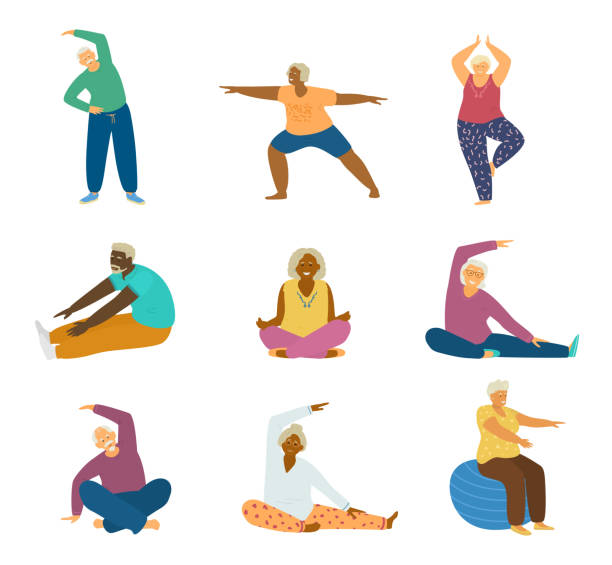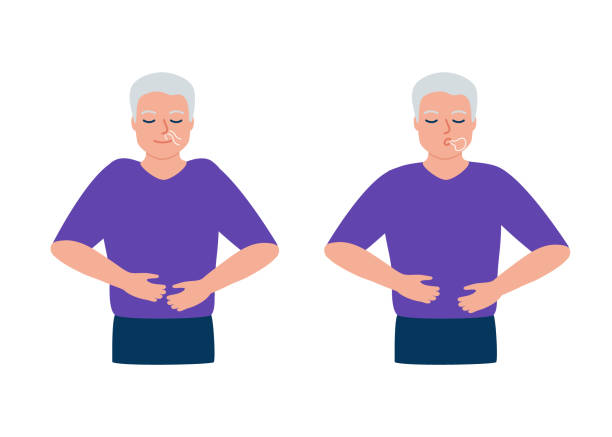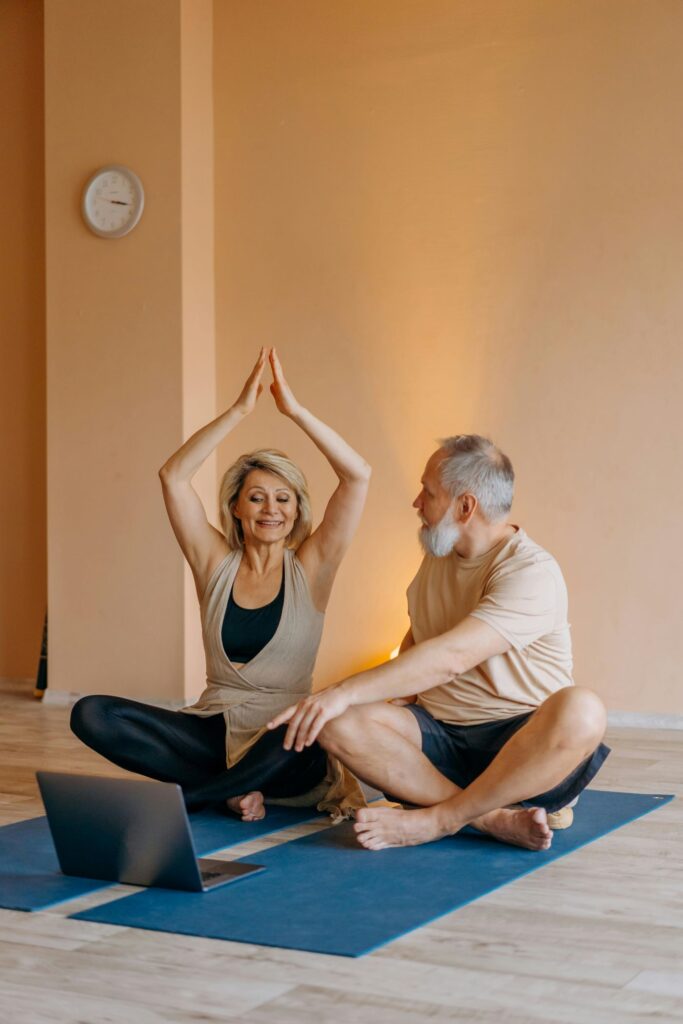Yoga is a practice that has been around for thousands of years and has been shown to have several health advantages. While yoga is often associated with young people, it can also be a great form of exercise for elders. In fact, yoga can be especially useful to seniors because it improves flexibility, balance, and overall well-being.
Yoga is especially useful for elders because it is a low-impact form of exercise. This means it is less prone to injure or strain joints, making it a good choice for anyone suffering from arthritis or other mobility issues. Yoga can also assist improve balance, which is vital for preventing falls, a significant issue among seniors.
There are numerous sorts of yoga practices that are appropriate for seniors, such as chair yoga, gentle yoga, and restorative yoga. These techniques can be adapted to accommodate any physical constraints and performed in a group or individual context. With so many health benefits, yoga is a fantastic alternative for seniors wishing to improve their overall health and well-being.

Understanding Yoga and Its Benefits for Seniors
Yoga is a popular form of exercise that combines physical poses, breathing methods, and meditation. It has been practiced for thousands of years and has gained popularity in recent years. Yoga has various benefits for elders, including increased flexibility, strength, balance, and mobility. It can also boost bone density, alleviate tension and discomfort, and promote relaxation and mental wellness.
Adapting Yoga for Age-Related Changes
Our bodies change as we age, which might have an impact on our ability to do particular yoga poses. Seniors may have decreased flexibility, strength, and balance, as well as reduced mobility and bone density. However, with certain changes and adaptations, yoga can remain a safe and effective form of exercise for seniors.
Seniors should consult with a skilled yoga instructor who can assist them alter practices to meet their specific needs. Props like blocks, belts, and blankets can help provide support and make positions more accessible. Seniors should also listen to their bodies and prevent overexertion, especially if they have any pre-existing health concerns.
Health Benefits of Regular Yoga Practice
Regular yoga practice can provide several health benefits to seniors. It can enhance flexibility, which can help you avoid falls and other accidents. It can also boost strength and balance, improving general physical function and lowering the risk of falls. Yoga can also increase bone density, which can help prevent osteoporosis.
Yoga can provide elders with both physical and emotional health advantages. It can alleviate tension and anxiety, boost mood, and promote relaxation. Yoga can also assist elders manage chronic pain and enhance their overall quality of life.
Finally, yoga can be a safe and beneficial type of exercise for elders. With certain changes and adaptations, seniors can reap the myriad physical and mental health advantages of regular yoga practice.

Essential Yoga Poses and Exercises for Older Adults
Yoga is an excellent approach for seniors to stay physically and mentally healthy. As we age, our bodies lose flexibility and our muscles and bones weaken. Yoga can assist to mitigate these impacts and boost overall health and well-being.
Gentle Poses to Enhance Flexibility and Mobility
Chair yoga is an excellent choice for seniors with restricted mobility. It entails executing yoga positions while seated in a chair, making it suitable for everyone. The following gentle positions help improve flexibility and mobility:
- Mountain pose: Stand tall with feet hip-width apart and arms at your sides. It improves posture and balance.
- Tree posture entails standing on one leg while the other foot rests on the opposite thigh. It improves balance and coordination.
- Butterfly pose: Sit with the soles of your feet touching and softly press the knees down. It helps to stretch the hips and lower back.
- Sphinx posture: In this pose, you lie on your stomach with your elbows under your shoulders and elevate your chest off the ground. It stretches the spine and improves posture.
Strengthening Poses for Improving Muscle and Bone Health
As we age, our muscles and bones deteriorate, which can result in falls and fractures. Yoga can help strengthen these areas and boost general wellness. Some strengthening positions suitable for elders include:
- Standing pose requires standing on both feet and using the muscles in the legs and core. Warrior 1 is an excellent standing pose for strengthening the legs and improving balance.
- Chair position: Sit back as if in a chair, then hold the pose for a few breaths. It strengthens the legs and core.
- Downward-facing dog: Begin on hands and knees, then lift the hips up and back. It strengthens the arms, shoulders, and legs.
Balance Poses to Prevent Falls and Improve Stability
Balance is a vital facet of general health, particularly for seniors who are at risk of falling. Yoga can help with balance and stability. Some balance positions suitable for elders include:
- Tree posture entails standing on one leg while the other foot rests on the opposite thigh. It improves balance and coordination.
- Warrior 1 pose: Stand with one foot forward and one foot back, arms raised overhead. It improves balance and strengthens the legs.
- Standing on one leg and wrapping the second leg over it, with arms crossed in front of the body, is known as the Eagle Pose. It improves balance and coordination.

Addressing Common Health Concerns with Yoga
As people age, they may develop a variety of health difficulties. Yoga can be a helpful treatment for some of these issues. Here are some examples of how yoga can benefit seniors with common health conditions.
Yoga For Arthritis And Joint Health
Arthritis is a prevalent ailment among the elderly. Yoga can help reduce joint pain and stiffness caused by arthritis. Certain yoga poses can enhance joint flexibility and range of motion. Gentle motions and stretches might also assist in alleviating joint inflammation.
Yoga for Osteoporosis and Bone Health
Osteoporosis is a condition in which the bones become weak and fragile. Yoga can increase bone density and strength. Weight-bearing yoga positions, such as standing and arm balances, can promote bone formation. Yoga can also enhance balance and posture, lowering the risk of falls and fractures.
Yoga for Cardiovascular and Respiratory Health
Yoga can also improve cardiovascular and respiratory health. Certain yoga poses can assist in enhancing circulation and reducing blood pressure. Deep breathing techniques, known as pranayama, can increase lung function and oxygenation. Regular yoga practice can also help reduce tension and anxiety, which can benefit one’s general health and well-being.
Finally, yoga has the potential to effectively address prevalent health conditions in seniors. Seniors who incorporate yoga into their daily practice can benefit from improved joint health, bone density, cardiovascular and respiratory health, and overall well-being. Before beginning any new fitness plan, you should consult with a healthcare expert.

Incorporating Yoga into Daily Life for Seniors
Yoga is a fantastic approach for seniors to stay physically and mentally healthy. It is a low-impact workout that may be readily added to their everyday routine. Here are some suggestions for seniors who want to begin practicing yoga:
Creating a Sustainable Yoga Routine
Seniors should begin with simple postures and progressively build up the intensity and duration of their practice. It is critical to listen to their bodies and avoid pushing themselves beyond their physical limits. They should try to practice yoga at least three times every week to reap the benefits.
Using Props and Modifications for Safety and Comfort
Seniors may have physical restrictions that make some positions difficult. They can utilize props like blocks, straps, and blankets to change the poses and make them more accessible. A certified yoga teacher can assist them in determining which changes are appropriate for their body.
Finding Community and Support in Senior Yoga Classes
Seniors can benefit from group yoga sessions. It gives them a sense of community and support. Many yoga classes for seniors are designed to meet their special needs. Seniors should look for a skilled yoga instructor with experience working with seniors.
Finally, elders can considerably benefit from practicing yoga. They can enhance their physical and emotional health by incorporating yoga into their daily routine, using supports and modifications, and connecting with others in senior yoga courses.


